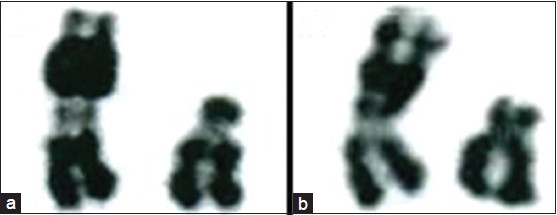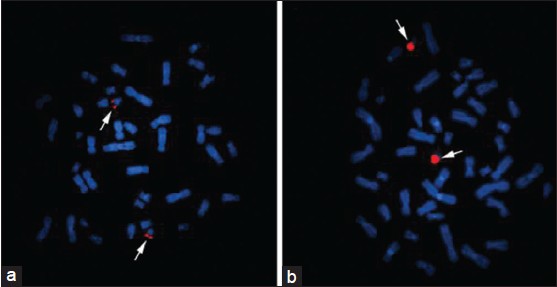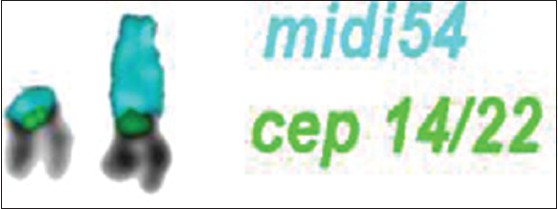|
 
 |
|
CASE REPORT |
|
|
|
| Year : 2014 | Volume
: 20
| Issue : 1 | Page : 89-91 |
| |
Characterization of a rare short arm heteromorphism of chromosome 22 in a girl with down-syndrome like facies
Abdelhafid Natiq1, Siham Chafai Elalaoui2, Thomas Liehr3, Saïd Amzazi4, Abdelaziz Sefiani2
1 Department of Medical Genetics, National Institute of Health; Faculty of Sciences of Rabat, University Mohamed V Agdal, Morocco, Africa,
2 Department of Medical Genetics, National Institute of Health; Human Genomic Center, University Mohamed V Souissi, Rabat, Morocco, Africa,
3 Department of Medical Genetics, University of Jena, Institute for Humangenetics, D-07740 Jena, Germany,
4 Department of Medical Genetics, Faculty of Sciences of Rabat, University Mohamed V Agdal, Morocco, Africa,
| Date of Web Publication | 19-May-2014 |
Correspondence Address:
Abdelhafid Natiq
Département de Génétique Médicale, Institut National d'Hygiène, 27 Avenue, Ibn Batouta, B. P. 769, 11400, Rabat, Morocco
 Source of Support: None, Conflict of Interest: None  | 1 |
DOI: 10.4103/0971-6866.132767

 Abstract Abstract | | |
Chromosomal heteromorphisms are described as interindividual variation of chromosomes without phenotypic consequence. Chromosomal polymorphisms detected include most regions of heterochromatin of chromosomes 1, 9, 16 and Y and the short arms of all acrocentric chromosomes. Here, we report a girl with Down-syndrome such as facies and tremendously enlarged short arm of a chromosome 22. Fluorescence in situ hybridization (FISH) with a probe specific for all acrocentric short arms revealed that the enlargement p arms of the chromosome 22 in question contained exclusively heterochromatic material derived from an acrocentric short arm. Parental studies identified a maternal origin of this heteromorphism. Cryptic trisomy 21 of the Down-syndrome critical region was excluded by a corresponding FISH-probe. Here, we report, to the best of our knowledge, largest ever seen chromosome 22 short arm, being ~×1.5 larger than the normal long arm.
Keywords: Acrocentric p arms, fluorescence in situ hybridization, heteromorphism, karyotype
How to cite this article:
Natiq A, Elalaoui SC, Liehr T, Amzazi S, Sefiani A. Characterization of a rare short arm heteromorphism of chromosome 22 in a girl with down-syndrome like facies. Indian J Hum Genet 2014;20:89-91 |
How to cite this URL:
Natiq A, Elalaoui SC, Liehr T, Amzazi S, Sefiani A. Characterization of a rare short arm heteromorphism of chromosome 22 in a girl with down-syndrome like facies. Indian J Hum Genet [serial online] 2014 [cited 2016 Aug 24];20:89-91. Available from: http://www.ijhg.com/text.asp?2014/20/1/89/132767 |
 Introduction Introduction | |  |
Chromosomal heteromorphisms are interindividual variation of chromosomes without phenotypic consequences and are detected most frequently in 1q12, 9q12, 16q11.2, Yq12 and in the short arms of acrocentric chromosomes (13, 14, 15, 21 and 22). In some cases, the enlarged acrocentric p arms of p arm can mask a cryptic translocation and therefore a partial trisomy. [1]
Here, we report a Moroccan 1½-year-old girl addressed for suspicion of trisomy 21 having an extremely enlarged p arm in one of her chromosomes 22.
 Case Report Case Report | |  |
The propositus was the first child of a consanguineous Moroccan family. She was 18 months old and only child of healthy parents. She was addressed for suspicion of trisomy 21/Down-syndrome. Her length was 78 cm (25 th centile), weight 10 kg (25 th centile) and head circumference 46 cm (50 th centile). She had no psychomotor delay but she had mild dysmorphism including round face, up slanting palpebral fissures, epicanthus, small nose, low-set ears and high arched palate [Figure 1]; echocardiography was normal. The propositus was delivered at 39 weeks of gestation. At birth the mother was 19 years and the father 24 years.
Cytogenetics
Cytogenetics studies were performed on metaphase chromosome preparations obtained from phytohemagglutinin stimulated lymphocyte cultures according to standard procedures. Chromosome analysis was carried out applying RHG banding at a 400 band level as previously reported and according to the International System for Human Cytogenetic: Nomenclature ISCN 2009. [2],[3] NOR staining was realized using standard protocols, as well.
Molecular cytogenetics
Fluorescence in situ hybridization (FISH) was carried out following respectively manufacturer's instructions and/or as previously reported. [4] First two commercially available probes were used: LSI 21 probe (ABBOTT Rιf. 30-19002) encompassing two genes DSCR4 and DSCR8 with 3 markers D21S259, D21S341, D21S342 in 21q22.13-q22.2 (Down-syndrome critical region) and a whole chromosome paint (WCP) 21 probe (CYTOCELL cat N° LPP21R). 50 metaphase and interphases cells were analyzed for each probe. Besides a microdissection derived home brew probe specific for all acrocentric short arms and denominated as midi54 [4] and a the centromere-specific probe D14Z1/D22Z1, which at the same time hybridizes to centromeres of chromosome 14 and 22 (KREATECH). | Figure 2: A partial R banding karyotype of the propositus (a) and her mother (b) showing enlarged short arm of one chromosome 22
Click here to view |
 Results Results | |  |
R banding analysis of the chromosomes from peripheral blood of the propositus revealed a normal karyotype apart from an enlarged short arm for one chromosome 22 inherited from the mother [Figure 2]. Thus, the karyotype was reported as 46, XX, der (22) add (22)(p13) mat. Applying the NOR staining results were quite variable and overall non-informative (data not shown).
A probe LSI 21 of the critical region for the Down-syndrome critical region and a WCP 21 probe excluded the presence of a cryptic trisomy 21 [Figure 3]. FISH using a probe for all acrocentric short arms characterized the additional material on the der (22) as heterochromatin derived from an acrocentric short arm [Figure 4]. Therefore, according to cytogenetic and molecular cytogenetic characterization the karyotype was 46, XX,22ph+++ mat. | Figure 3: Metaphases hybridized with Down-syndrome critical region probe LSI 21 (a) and whole chromosome paint (WCP) for chromosome 21 (b). (a) LSI showed 2 normal signals at the study locus 21q22.13-q22.2. (b) WCP 22 revealed a complete hybridization of the two long arms of chromosome 21. Neither der 22 nor other chromosomes revealed signal for any of the two probes
Click here to view |
 | Figure 4: The short arm of the chromosome 22p++ on the right was completely stained by a probe specific for the acrocentric short arm (midi54) indicating its heterochromatic nature
Click here to view |
 Discussion Discussion | |  |
Cytogenetic and FISH investigation of the propositus excluded (cryptic) trisomy 21 as already reported in Down-syndrome like syndrome phenotypes. [5] Instead of clarifying the genetic reason of the clinical problems in this specific case unexpectedly a familial 22ph+++ was detected and further characterized. Uninformative results as seen after NOR silver staining was reported by some authors as well, previously. [6],[7],[8] Thus, nowadays FISH analysis is more straightforward for the characterization of heteromorphisms in general and acrocentric short arm variants in special. [1] This kind of molecular cytogenetic analysis also enables to distinguish heteromorphic variants from partial trisomies due to cryptic translocations. [1] Most likely heterochromatin loss or gain are not causative for acquired or inherited disorders, even though such relations still are discussed. [9],[10]
To the best of our knowledge, this special here reported kind of chromosome 22 short arm enlargement, leading ro ~×1.5 larger size than the normal "long arm" was never described before.
 Conclusion Conclusion | |  |
FISH should always be used to resolve similar situations involving cytogenetic aberrations within the short arms of acrocentric chromosomes. Further follow-up of the propositus may allow us to have more clinical information and making some correlations between this heteromorphism and/or other genetic changes below the cytogenetic resolution and the phenotype of the patient.
 Acknowledgments Acknowledgments | |  |
The authors would like to thank the patient and her family for collaboration.
 References References | |  |
| 1. | Starke H, Mrasek K, Liehr T. Three cases with enlarged acrocentric p-arms and two cases with cryptic partial trisomies. J Histochem Cytochem 2005;53:359-60. 
|
| 2. | Aboussair N, Jaouad IC, Dequaqui SC, Sbiti A, Elkerch F, Yahya B, et al. Cytogenetic analysis of 5572 patients referred for suspected chromosomal abnormalities in Morocco. Genet Test Mol Biomarkers 2012;16:569-73. 
|
| 3. | Shaffer L, Slovak ML, Campbell LJ. In: ISCN, editor. An International System for Human Cytogenetic Nomenclature. Basel: Karger; 2009. 
|
| 4. | Mrasek K, Heller A, Rubtsov N, Trifonov V, Starke H, Rocchi M, et al. Reconstruction of the female Gorilla gorilla karyotype using 25-color FISH and multicolor banding (MCB). Cytogenet Cell Genet 2001;93:242-8. 
|
| 5. | Ronan A, Fagan K, Christie L, Conroy J, Nowak NJ, Turner G. Familial 4.3 Mb duplication of 21q22 sheds new light on the Down syndrome critical region. J Med Genet 2007;44:448-51. 
|
| 6. | Reddy KS, Sulcova V. The mobile nature of acrocentric elements illustrated by three unusual chromosome variants. Hum Genet 1998;102:653-62. 
|
| 7. | Schmid M, Nanda I, Steinlein C, Epplen JT. Amplification of (GACA) n simple repeats in an exceptional 14p+marker chromosome. Hum Genet 1994;93:375-82. 
|
| 8. | Yandt HE, Tonk VS. Atlas of Human Chromosome Heteromorphisms. Dordrecht, Boston, London: Kluwer Academic Publishers; 2004. 
|
| 9. | Gourzis P, Skokou M, Polychronopoulos P, Soubasi E, Triantaphyllidou IE, Aravidis C, et al. Frontotemporal dementia, manifested as schizophrenia, with decreased heterochromatin on chromosome 1. Case Rep Psychiatry 2012;2012:937518. 
|
| 10. | Millington K, Hudnall SD, Northup J, Panova N, Velagaleti G. Role of chromosome 1 pericentric heterochromatin (1q) in pathogenesis of myelodysplastic syndromes: Report of 2 new cases. Exp Mol Pathol 2008;84:189-93. 
|
[Figure 1], [Figure 2], [Figure 3], [Figure 4]
| This article has been cited by | | 1 |
19q13.33?qter trisomy in a girl with intellectual impairment and seizures |
|
| Gianna Carvalheira,Mariana Moysés Oliveira,Sylvia Takeno,Fernanda Teresa de Lima,Vera Ayres Meloni,Maria Isabel Melaragno | | Meta Gene. 2014; 2: 799 | | [Pubmed] | [DOI] | |
|
 |
|






